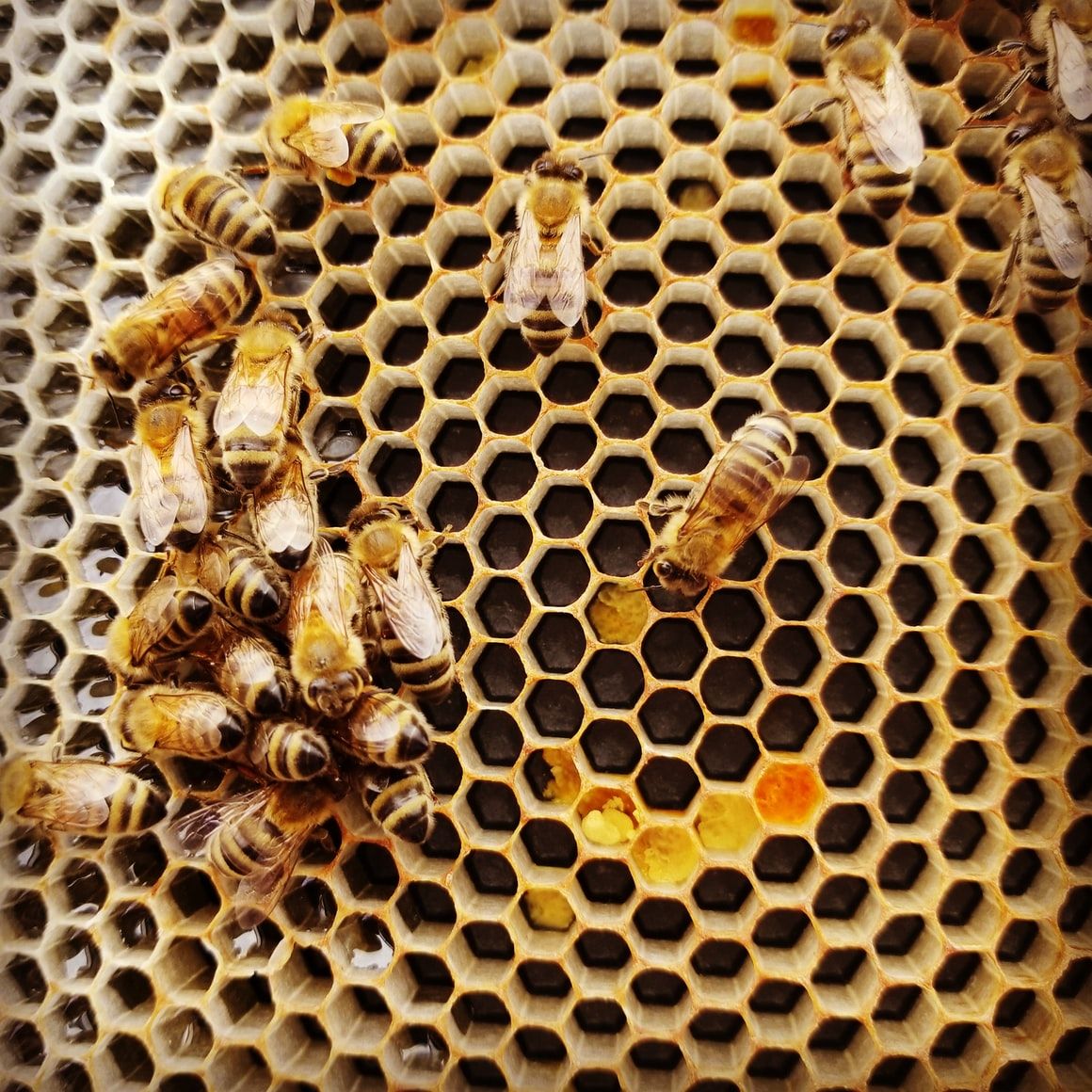Notes on the Eusocial Nature of Bees

I came across this paper while looking for descriptions of hierarchical organization within honeybee hives. The following includes comprehensive notes and thoughts from the paper "Revising the Superorganism" by Canciani et al (2019).
Notes on: Revising the Superorganism: An Organizational Approach to Complex Eusociality
-
Eusociality as example of social integration; defined as:
- Colonies consisting of overlapping generations
- Cooperative brood care
- Reproductive division of labor, where non-reproductive (sterile) workers help reproductive members
-
Development and maintenance of eusociality is supported by complex organization via control
- Example: chemical exchanges (pheromones)– hormones outside of the body of the agent, modifying the physiological structure and behavior of neighboring members
- Example: royal jelly
-
Widely held view: Eusocial colonies are self-organized (SO) systems
- SO approach: local interactions between parts of a disordered system; feedback loops that emerge as a result of a set of local interactions between parts of the colony without need of hierarchical control
- HOWEVER-- this paper challenges the view that hierarchical control and regulation does not occur / is not necessary in complex eusocial colonies... instead, paper posits that some complex eusocial colonies actually do demonstrate hierarchical-organizational (HO) approach
-
Self-Organization approach (SO)
- Positive and negative feedback loops resulting from multiple interactions between insects, and the amplification of random fluctuations in those interactions
-
Hierarchical-Organizational approach (HO)
- First order signals – straight forward feedback loops
- JH, Vg – Internal to each worker
- Ethyl oleate – Foragers >> Nest workers
- Second order signals – dynamically decoupled from the systems they modulate (i.e. internal developmental systems of individual workers); for example brood emits signals that impacts worker bee development, but the emitter is not part of the change themselves… hierarchical (i.e. decoupled) force at play
- QPM – Queen >> induces nurses and nest workers to delay further development (take care of queen)
- Brood ester – Old brood >> induces nurses to stay longer (support older brood)
- E-B-ocimene – Young brood >> induces nest workers to accelerate into foragers (more food for hungry brood)
- Second order signals allow for hierarchical control of the worker caste ratio… “The control and regulation of the ratio of workers within each caste is not dependent on a change in concentration of the workers themselves but instead on second-order signals that can modulate the existing workers”
- First order signals – straight forward feedback loops
-
Honey bees demonstrate hierarchically organized network of interactions with the colony
- Example 1 – Temporal polyethism & worker castes
- Queen is the only reproductive member; worker bees not reproductively active
- In addition, further division of labor: “temporal polyethism schedule”… leading to temporal worker castes.
- Worker bees transition through these castes as they age; Due to different hormones
- Juvenile hormone (JH)
- Vitellogen levels (Vg)
- Nurse (low JH, high Vg), age 2-11 days – feeding / raising brood + queen / other members of colony
- Nest worker (increasing JH, decreasing Vg), age 11-18 days – construction & maintenance, ventilation, processing nectar into honey, storing honey & pollen, etc
- Forager (high JH, low Vg), age 18+ days – foraging for nectar, pollen, water
- These hormones impact biology of bees (example: move from producing jelly for brood (nurse) to producing enzymes for nectar processing (nest)
- Worker bees transition through these castes as they age; Due to different hormones
- Added signals from queen, brood (youngest), foragers (oldest) impacts the schedule & ratio of each caste type
- Queen – inhibitory effect on JH via queen’s own pheromone mix (QPM). For example, in presence of QPM, workers have delayed JH biosynthesis compared to those not exposed to QPM, (i.e. remain as nurse / nest worker longer)
- Brood –
- Younger brood – emits E-B-ocimene, a volatile pheromone transmitted into the nest aerially, that targets nest workers and causes increased development so they transition to foragers sooners
- Older brood – emits brood ester, which targets nurses and delays their development into nest workers
- Forager cast – emits ethyl oleate, transmitted via tophallaxis when forages pass nectar loads to nest workers… inhibits nest workers from transitioning into forager caste by slowing down their development
- Example 2 – Queen / worker production
- Remember, for honey bees, whether a bee is reproductive or non-reproductive (worker cast) is not genetically determined; any fertilized egg can become a queen or a worker. This is determined by: a) environment, and b) nutrition
- Environment – large queen cells
- Controlled by nest workers (construction), when required by the colony at large
- Nutrition – royal jelly
- Not just nutritional value, accelerated metabolism and affects DNA methylation… induces epigenetic change in developing larvae
- Controlled by nurses, when required by the colony at large
- “Specifically, the nest worker caste will produce worker cells when the colony requires workers or produce queen cells when the colony requires queens. The nurse caste feeds all larvae present in the colony; feed brood food to worker cells and royal jelly to queen cells”
- Means: the nurse and nest worker castes are dynamically decoupled from the process of caste determination; the nurse and nest worker castes operate at a different timescale to the systems they modulate (ie. the internal development of the larvae)
- “This enables caste determination to be hierarchically controlled at the collective level, rather than being regulated locally via self-organization”
- Environment – large queen cells
- “The temporal polyethism schedule within each worker is regulated hierarchically at the colony level via second-order signals”
- Remember, for honey bees, whether a bee is reproductive or non-reproductive (worker cast) is not genetically determined; any fertilized egg can become a queen or a worker. This is determined by: a) environment, and b) nutrition
- Example 1 – Temporal polyethism & worker castes
My Notes: Related to Elinor Ostrom / DAOs
-
E Ostrom's 8 Principles for managing commons are:
- Define clear group boundaries
- Match rules governing use of common goods to local needs and conditions
- Ensure that those affected by the rules can participate in modifying the rules
- Make sure the rule-making rights of community members are respected by outside authorities
- Develop a system, carried out by community members, for monitoring members’ behavior
- Use graduated sanctions for rule violators
- Provide accessible, low-cost means for dispute resolution
- Build responsibility for governing the common resource in nested tiers from the lowest level up to the entire interconnected system
- However, Ostrom's principles are for managing, i.e. MAINTAINING commons. Does this still work when you're also trying to BUILD the commons, in addition to maintaining it, too?
- Honeybees organize to both build AND maintain. (Note that the paper above calls out maintenance multiple times.) How might Hierarchical vs. Self-organized organization relate to Ostrom's Principles in the building stage?
-
Hierarchical organization vs. Self-organized
- SO: Positive and negative feedback loops resulting from multiple interactions between insects, and the amplification of random fluctuations in those interactions
- HO: Controller / regulator is dynamically decoupled from the systems they modulate; operators at different timescales…
-
So which is better to structure a building incentive blockchain: Self Organization or Hierarchical Organization… all localized or better at the superorganism / colony scale?
- Likely hierarchical organization… hierarchically controlled at the collective level rather than regulated locally via self-organization
- Probably benefit of a DAO is that get both
- Get localized action, based on rules
- AND
- Collective determination
